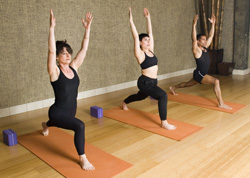What do I wear and bring?

Come dressed in stretchy, comfortable clothes and plan to practice in bare feet. (Socks are OK if necessary.) You may want a warmer outer layer to wear during “savasana” (final relaxation). We provide the mats and props for use at the studio. Once you get started, for hygienic reasons, you may decide to purchase your own mat, blanket or cushion. These are available in our boutique.
Avoid eating just before doing yoga; but drink water before and after class.
Prenatal students should eat lightly about an hour before class and may bring water and a snack as well.
What if I haven’t exercised for awhile, can’t touch my toes or have a physical challenge?
That’s OK. “I’m not flexible!” is the most common thing we hear from new students. You don’t have to be able to tie yourself into a pretzel to enjoy a yoga practice. Yoga is noncompetitive and everyone is encouraged to practice at their own pace and listen to their body’s messages. It’s not about doing the pose perfectly, it’s about receiving the benefits of the pose in a way that serves your body as it is today. It is often the tight, inflexible body that receives the benefits most quickly from yoga.
Be sure to arrive 10 minutes early for the first class and always tell an instructor if you’ve had an injury or an area of concern in your body. All of our teachers are able to provide you with modifications to the poses so they will be accessible to you. You may want to consider a Gentle Yoga Series to ease you into a regular practice.
How are your classes different from what I can take at a gym or fitness club?
At Three Trees you can expect skillful, certified yoga teachers. We require a minimum of 200 hours of training before we entrust our students to their care. This assures you that the classes will be designed intelligently and with attention given to your individual needs.
The experience of yoga is as much about reducing stress and tension in the mind as it is about the body. That is one of the reasons we make it a priority that our studio is clean and quiet and a pleasure to practice in. The radiant heat floors are made from beautiful bamboo wood. (We made sure to leave a portion of the floor without heat for those who generate more than enough from within!) Soothing music, fresh flowers, candles, a view of our rock wall garden through the window, and lavender scented eye pillows are a few of the details that make the experience of yoga at Three Trees nourishing and rejuvenating.
Is there chanting and meditation? How does yoga fit with my own faith?
There may be times of guided or silent meditation-usually just for a few minutes. It is also common to chant “OM” or “Shanti” at the beginning or end of class although participation is always optional. OM is used as the symbol of yoga and is a Sanskrit word meaning “unity”. It refers to the interconnectedness of all things. “Shanti” means “peace”. These tools are helpful in creating quiet within the mind. They are offered in the spirit of supporting your individual faith or life philosophy.
I’m worried about getting injured. Is yoga safe for me?
It all comes back to the quality of the yoga teacher’s training and your own commitment to listen to your body and honor what it tells you. There are yoga classes at other facilities that are focused on making the class a challenging fitness regimen. There is little instruction on how to move intelligently in and out of postures and how to release your own ego drive to strive beyond what is healthy for you.
Be sure that wherever you practice yoga the teacher has had a minimum of 200 hours teacher training. Ideally this instruction should be done over the course of several months rather than in one quick intensive so there is time for the teacher to absorb the information and put it to use.
No pain, no gain? That’s not yoga.
A well trained teacher will give lots of modifications for poses so there is a healthy option for each student in the class and doesn’t teach only the most challenging version of the pose and expect every one to simply keep up. High quality teachers will not just demo the poses, but will look at the students in the room and give cues and suggestions to ensure that participants are practicing safely. Ultimately, the responsibility for coming out of a pose, resting rather than continuing, or moving into a posture only so far as it is comfortable lies with the student. Since no teacher can know exactly what a participant is experiencing or what their limit is, each student must learn how to pay attention to the messages that the body gives and stop when they’ve neared their edge. A good instructor will frequently remind students of this process and create an environment that fosters healthy exploration and respect for one’s own inner guidance.
